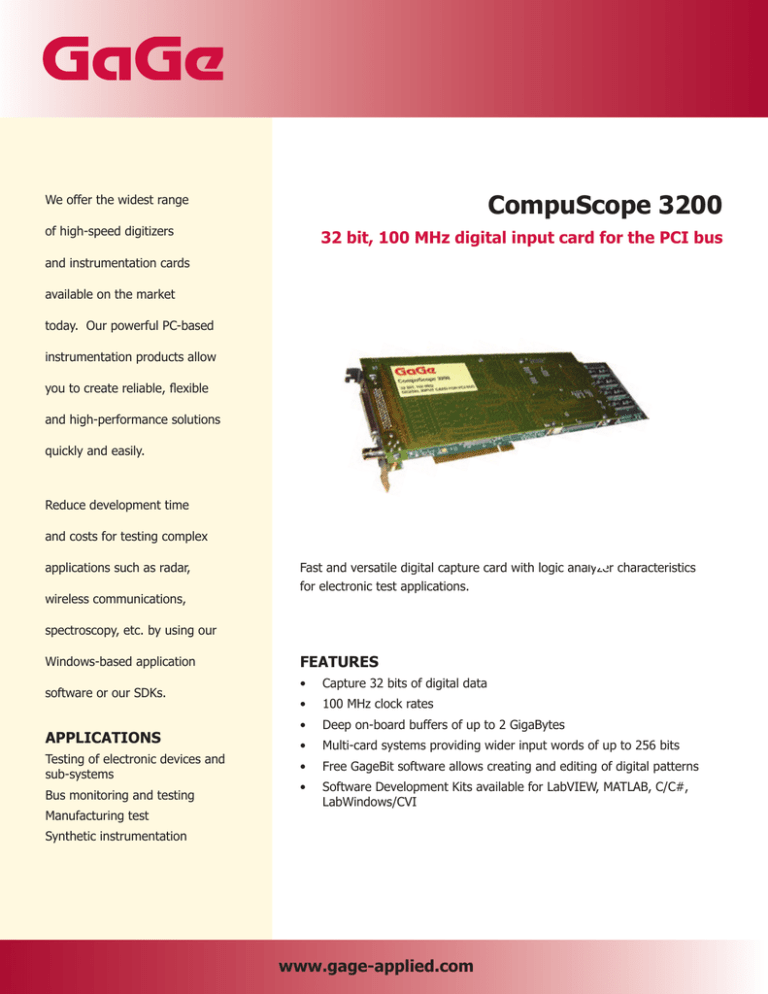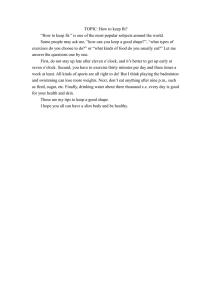
CompuScope 3200
We offer the widest range
of high-speed digitizers
32 bit, 100 MHz digital input card for the PCI bus
and instrumentation cards
available on the market
today. Our powerful PC-based
instrumentation products allow
you to create reliable, flexible
and high-performance solutions
quickly and easily.
Reduce development time
and costs for testing complex
applications such as radar,
wireless communications,
Fast and versatile digital capture card with logic analyzer characteristics
for electronic test applications.
spectroscopy, etc. by using our
Windows-based application
software or our SDKs.
APPLICATIONS
Testing of electronic devices and
sub‑systems
Bus monitoring and testing
Manufacturing test
Features
•
Capture 32 bits of digital data
•
100 MHz clock rates
•
Deep on-board buffers of up to 2 GigaBytes
•
Multi-card systems providing wider input words of up to 256 bits
•
Free GageBit software allows creating and editing of digital patterns
•
Software Development Kits available for LabVIEW, MATLAB, C/C#,
LabWindows/CVI
Synthetic instrumentation
www.gage-applied.com
CompuScope 3200 Simplified Block Diagram
COMPUSCOPE 3200
CONFIGURABLE INPUT
The CS3200 can also be configured, in software, to be either 8, 16 or
32 bits wide, thereby allowing the user to maximize the use of storage
memory for 8 or 16 bit inputs.
The presence of this FPGA also makes it possible to build customized
digital acquisition systems, including front-end data processing, for
specific requirements. Contact the
factory for such custom applications.
The CS3200 is a PCI bus based product which allows the user to capture
up to 32 bits of CMOS or ECL digital data into on-board memory at clock
rates up to 100 MHz. The inputs can be set at the factory to be either
differential or single-ended.
Multiple CS3200 boards can be used in Master/Slave configuration to
provide wider input words of 64, 96 or 128 bits.
INPUT CIRCUITRY
The input stage of the CS3200 consists of 34 high speed comparators:
32 for data and one each for clock and trigger. The use of high speed
comparators with fully programmable thresholds allows the use of
virtually any logic level: 5 Volt TTL/CMOS, 3.3 V CMOS, 2.7 V CMOS,
ECL, PECL or even custom logic levels.
In order to avoid signal reflections, all CS3200s are terminated by a
50 Ohm resister. Consequently, inputs need to be driven by a source
capable of driving a 50 Ohm load. This is necessary in order to maintain
good signal integrity.
For CMOS or TTL signal sources not capable of driving 50 Ohm loads, a
special CMOS Buffer Board is available from Gage which buffers the data
with 50 Ohm line drivers. The input of the Buffer Board is a 68 pin IDC
header for data, a BNC connector for Trigger and another BNC for Clock
input. All signals must be 0 to 3.3 V or 0 to 5V CMOS or TTL signals.
The output of the CMOS Buffer Board is a 68 pin MDR connector which
connects to the CS3200 using a 6 foot long pleated foil cable, supplied
with the CS3200.
Differential ECL or PECL signals are, by definition, capable of driving a
50 Ohm load and interface seamlessly with the CS3200.
The output of the on-board comparators is fed into an on-board FPGA
which demultiplexes the data from 8, 16 or 32 bits to the 64 bit width
required by CP500 board under software control.
The only choice customers must
make at the time of placing the order
is whether they require a differential
input or single-ended input CS3200.
This setting must be configured at
the factory and cannot be modified in
the field.
ON-BOARD MEMORY
The CS3200 stores digital data in on-board memory which is addressable
through the PCI bus under software control.
The memory on-board a CS3200 consists of high-speed Static RAM
whose default size is 2 MB. Models with 8 MB, 16MB, 128MB, 512MB,
1GB and 2GB are also available.
The on-board memory is configured as a circular buffer, so it is possible
to store both pre and post trigger data. In other words, it is possible to
wait indefinitely for a trigger event and then capture digital data from
both before and after this event.
The amount of data words which can be captured into on-board memory
is a function of the size of the memory and input width. For example,
a 16 MB model provides 16 million words of storage when the input
is 8 bits wide. The same model can only provide 4 million samples of
memory with 32 bit word width.
www.gage-applied.com
MEMORY MODE
Memory mode is the standard mode of operation of the CS3200. In
this mode, data is stored in the very deep on-board memory buffers.
A maximum throughput of 400 MB/s can be maintained in this mode.
TRANSFERRING DATA TO PC MEMORY
The CS3200 is fully capable of acting as a bus master to DMA captured
data into user buffers.
Scatter-Gather DMA is also supported in the Windows environment,
making it possible to manipulate data in a Windows program without
having to create special, physically contiguous buffers combined with
slow memcopy commands.
EXTERNAL CLOCK
The CS3200 allows the use of either internal or external clocks. External
clock can be very useful in systems which require synchronous data
capture. These applications include A/D Testing, Telecommunication,
DSP Systems, Video, Ultrasonic Imaging, etc.
The external clock is carried on the 68 wire input connector. A high
speed comparator converts the input level of the clock to CMOS/TTL
levels used by the on-board data latching and demultiplexing circuitry.
The maximum frequency of the input clock is 100 MHz. The driving
circuitry on the user’s circuit must be capable of driving a 50 Ω load.
CLOCK EDGE SELECTION
The user is able to select either the rising or falling edge of the input
clock to latch the data.
This flexibility allows the user to apply the CS3200 in situations in
which one of the clock edges and input data do not satisfy the timing
requirements. In such cases, using the opposite edge of the clock may
resolve the timing conflict.
CLOCK AND DATA TIMING
CRYSTAL BASED TIMEBASE
The CS3200 allows the use of both Internal or External clock under
software control.
When the internal clock is selected, the sampling clock is provided by a
crystal controlled oscillator, thereby providing very good short and long
term timing accuracy.
When an external clock is used, the timing accuracy depends entirely on
the quality of the external clock supplied by the user.
INPUT CONNECTOR
The data is input to the CS3200 over a 68 wire Pleated Foil cable. The
input connector is a 68 pin MDR socket (P/N 3M 0268‑55H3VC). The
mating connector is a 3M 10168-6000EC.
The Mating connector hood
is a 3M 10368‑A230‑00.
Each CS3200 is
supplied with a 6 foot
Pleated Foil cable
featuring the 3M
10168-6000EC
connector.
6 Foot Pleated Foil Cable
TRIGGER
A trigger input is provided on the CS3200. The configuration of this input
is set at the factory as either differential or single-ended.
It is possible to trigger either on the rising or falling edge of this trigger input.
In Normal mode, both pre and post trigger data are captured into
on‑board memory. In Multiple Recording mode, only post trigger data is
stored in on-board memory.
For timing information on trigger input with respect to clock, please see
Figure 2.
If the customer operates the CS3200 with an external clock, it should
be kept in mind that the maximum speed of the input clock is 100 MHz.
The minimum clock frequency is zero, i.e. the clocks can be started
and stopped at will, as long as the clocks are being supplied during
initialization and arming of the CS3200.
The setup and hold times of the data with respect to the active edge of
the clock must satisfy the minimum requirements listed in figure 1 below.
T
tsu
Min
tWL
tTW Trigger Pulse Width
7 ns
tTh Hold time ↑CLOCK to Trigger
0 ns
tTsu Setup Time TRIGGER to ↑CLOCK 7 ns
tWH
Note
1
2
2
Note 1:If Negative trigger slope (edge) is used, this specification must be satisfied
by the low-going pulse.
Note 2: ↑CLOCK = Active clock edge.
These parameters apply to the active edge of CLOCK and TRIGGER. If inverted
CLOCK is used or negative slope is used for TRIGGER, these parameters must
be satisfied relative to the falling edge of CLOCK or low-going pulse on TRIGGER
th
tsu
th
tWH
tWL
T
Setup Time DATA to ↑CLOCK
Hold Time ↑CLOCK to DATA
CLOCK Positive Pulse Width CLOCK Negative Pulse Width
CLOCK Period
Min
Note
5 ns
0 ns 5 ns 5 ns
10 ns
1
1
1
1
1
Figure 2: CLOCK TO TRIGGER TIMING
TRIGGER OUTPUT
Note 1: ↑CLOCK = Active clock edge.
All these timing parameters apply to the active edge of the clock.
If the inverted clock is used, these parameters must be satisfied relative to
the falling edge of the CLOCK
Figure 1: CLOCK TO DATA TIMING PARAMETERS
A Trigger Output signal is also provided by the CS3200. This signal is
synchronized to the internal clock which runs the demultiplexed memory
counters. As such, there can be a latency of as much as 8 clock cycles
between a trigger input and a trigger output.
This Trigger Output can be used to synchronize an entire system to
Gage’s internal clock.
www.gage-applied.com
SLOT USAGE
Pin Layout on CS3200 Connector
CS3200 boards occupy one full-length PCI slot for the standard 2MB
memory depth, two slots for the 8MB and 16MB memory depths and
3 slots for 128MB, 512MB, 1GB and 2GB memory versions.
Single-Ended (Differential)
1
CLK +
35
GND (CLK -)
2
D0 +
36
GND (D0 -)
3
D1
37
GND (D0 -)
4
D2
38
GND (D0 -)
5
D3
39
GND (D0 -)
6
D4
40
GND (D0 -)
7
D5
41
GND (D0 -)
8
D6
42
GND (D0 -)
9
D7
43
GND (D0 -)
10
D8
44
GND (D0 -)
11
D9
45
GND (D0 -)
12
D10
46
GND (D0 -)
13
D11
47
GND (D0 -)
14
D12
48
GND (D0 -)
15
D13
49
GND (D0 -)
16
D14
50
GND (D0 -)
17
D15
51
GND (D0 -)
18
D16
52
GND (D0 -)
19
D17
53
GND (D0 -)
20
D18
54
GND (D0 -)
21
D19
55
GND (D0 -)
22
D20
56
GND (D0 -)
23
D21
57
GND (D0 -)
24
D22
58
GND (D0 -)
25
D23
59
GND (D0 -)
26
D24
60
GND (D0 -)
27
D25
61
GND (D0 -)
28
D26
62
GND (D0 -)
29
D27
63
GND (D0 -)
30
D28
64
GND (D0 -)
31
D29
65
GND (D0 -)
32
D30
66
GND (D0 -)
33
D31
67
GND (D0 -)
34
TRIG IN +
68
GND (TRIG -)
PIN 1
______
______
PIN 35
It is important
to note that
the CS3200 is
a full length
PCI board
and requires
proper
mechanical
clearance in
the computer
chassis.
Extended Memory Board
The Extended Memory Board for the 8 and 16 M versions of CS3200
take up the space of two slots. Higher memory versions occupy the
space of 3 slots. Contact Factory for 2-slot deep memory solution.
SOFTWARE SUPPORT
PIN 34
______
______
PIN 68
The CS3200 operates under GageBit -- Gage’s Digital Input/Output
Software for Windows. GageBit allows the CS3200 to be operated in all
available operating modes. Captured digital samples can be displayed
graphically, with each bit plotted as a function of time. Digital samples
can also be displayed in a list box as decimal, hexadecimal or binary
representations. Data can also be logically manipulated and stored to file.
GageBit also supports the CompuGen 3250, the natural complement
to the CS3200. GageBit is able to generate a digital pattern with the
CG3250, capture data with the CS3200 and compare the results.
The CS3200 is also supported by all CompuScope SDKs, each of which include
specific digital input sample programs illustrating the use of the CS3200.
SYSTEM REQUIREMENTS
PCI-based computer with at least one free full-length PCI slot, 128 MB
RAM, 50 MB hard disk and SVGA video.
SIZE
Plugs into 1 full length PCI Slot. 13” x 4.1”
Memory Depth:
Board Occupies:
2MB
1 full length slot
8MB & 16MB
2 full length slots
128MB & 512MB
3† full length slots
1GB & 2GB
3† full length slots
† Contact factory for optional 2-slot deep memory solution.
POWER (IN WATTS)
+5 V
Memory Depth
Worst case
Typical
2M
8M
16M
128M
512M
1G
2G
28.6
31.6
31.6
33.6
36.1
36.1
38.6
26.0
29.0
29.0
30.0
32.0
32.0
34.0
www.gage-applied.com
INPUT
MULTI-CARD SYSTEMS
Input Connector:
Number of Data Lines: Input Type:
Input Levels:
Single Ended: Differential: 68 Pin MDR connector
32, 16, or 8; Software-selectable
Single Ended or Differential, factory set.
Can not be modified in the field.
CMOS (0 to 5 Volts),
CMOS (0 to 3.3 Volts)
ECL or PECL
Operating Mode:
Maximum Number of Cards:
Master/Slave:
Multiple/Independent: Master/Slave or Multiple/Independent
2M models: 2 to 8 cards
8M & 16M models: 2, 3 or 4 cards
128M & higher models: 2 or 3 cards
Limited by backplane
PCI BUS INTERFACE
CLOCK
Internal Clock Rate: MHz: 100, 50, 20, 10, 5, 2, 1
kHz: 500
External Clock: Standard
External Clock Type:
Single Ended or Differential, set to the
same type as data lines
External Clock Level: Set to the same type as data lines.
CMOS/TTL inputs are 3.3 Volt tolerant.
Single-Ended: CMOS (0 to 5 Volts),
CMOS (0 to 3.3 Volts),
TTL (0 to 5 Volts);
Software-selectable
Differential:
ECL, PECL; Software-selectable
Max. External Clock Frequency:100 MHz
Min. External Clock Frequency: DC
Impedance:
50 W
TRIGGERING
Source: External Trigger or Software
External Trigger:
Standard
Trigger Type: Single Ended or Differential, set to the
same type as data lines
Trigger Level: Set to the same type as data lines.
CMOS/TTL inputs are 3.3 Volt tolerant.
Single-Ended:
CMOS (0 to 5 Volts),
CMOS (0 to 3.3 Volts),
TTL (0 to 5 Volts);
Software-selectable
Differential:
ECL, PECL; Software-selectable
Slope:
Positive or Negative
Post-Trigger Depth:
8 bits
256 point minimum
128 point resolution
16 bits 128 point minimum
64 point resolution
32 bits 64 point minimum
32 point resolution
Plug-&-Play:
Bus Mastering:
Bus Width:
Bus Throughput:
Compatibility:
Fully supported
Fully supported
32 bit
100 MB/s to PC Memory
All PCI compliant computers
OPERATING SYSTEMS SUPPORTED
Windows 98/ME/NT*
CompuScope Driver version 3.60.22
* Version 4, SP3 or higher
Windows 2000**/XP
CompuScope Driver version 4.xx.xx
** SP1 or higher
SOFTWARE DEVELOPMENT KITS (SDK)
CompuScope
CompuScope
CompuScope
CompuScope
SDK
SDK
SDK
SDK
for
for
for
for
C/C# for Windows
MATLAB for Windows
LabVIEW for Windows
LabWindows/CVI for Windows
APPLICATI0N SOFTWARE
GageBit Application for Windows
ELECTROMAGNETIC COMPATIBILITY
EC Council Directive 89/336/EEC
Compliant
EN 61326 Class A
IEC 61000-4-2 Electrostatic Discharge (Performance Criterion B)
IEC 61000-4-3 RF Electromagnetic Field (Performance Criterion A)
IEC 61000-4-4 Electrical Fast Transient/Burst (Performance Criterion B)
IEC 61000-4-5 Power Surge (Performance Criterion B)
IEC 61000-4-6 Conducted RF (Performance Criterion A)
IEC 61000-4-11 Voltage Dips & Interruptions (Performance Criterion B)
EN 61000-3-2 AC Power Line Harmonics Emissions
AS/NZS 2064
Australian emissions standard for Industrial, Scientific & Medical Equipment
Compliance demonstrated on a single card configuration
MEMORY MODE OPERATION
Data Storage:
On-board Memory Size:
In on-board memory
2 MB, 8 MB, 16 MB, 128 MB, 512 MB, 1 GB, 2 GB
Width
2M
8M
16 M
128 M
512 M
1 GB
2 GB
8 bit
2 million
8 million
16 million
128 million
512 million
1 billion
2 billion
16 bit
1 million
4 million
8 million
64 million
256 million
512 million
1 billion
32 bit
512K
2 million
4 million
32 million
128 million
256 million
512 million
8-bit words
16-bit words
32-bit words
8-bit words
16-bit words
32-bit words
8-bit words
16-bit words
32-bit words
8-bit words
16-bit words
32-bit words
8-bit words
16-bit words
32-bit words
www.gage-applied.com
8-bit words
16-bit words
32-bit words
8-bit words
16-bit words
32-bit words
MATERIALS SUPPLIED
One CompuScope 3200 card
One Hardware Manual
Pleated Foil Cable
One Gage CompuScope CD
Includes GageBit Software
Optional ACCESSORIES
CS3200: Buffer Board
CS32x0: BNC Breakout Board
WARRANTY
One year parts and labor
All specifications subject to change without notice;
specifications are not guaranteed under all possible combinations of modes of operation.
ORDERING INFORMATION
Hardware & Upgrades
CMOS or TTL
CompuScope 3200
CompuScope 3200
CompuScope 3200
CompuScope 3200
CompuScope 3200
CompuScope 3200
CompuScope 3200
-
2M
8M
16M
128M
512M
1G
2G
320-161-001
320-161-002
320-161-003
320-161-004
320-161-005
320-161-006
320-161-007
Differential ECL
CompuScope 3200
CompuScope 3200
CompuScope 3200
CompuScope 3200
CompuScope 3200
CompuScope 3200
CompuScope 3200
-
2M
8M
16M
128M
512M
1G
2G
320-161-020
320-161-021
320-161-022
320-161-023
320-161-024
320-161-025
320-161-026
CS3200 Memory Upgrades
Master Multi-Card Upgrade
Slave Multi-Card Upgrade
Contact Factory
320-181-103
320-181-104
CS3200: Buffer Board
CS32x0: BNC Breakout Board
320-181-105
320-181-143
Software Development Kits (SDKs)
Gage SDK Pack on CD
CompuScope SDK for C/C#
CompuScope SDK for MATLAB
CompuScope SDK for LabVIEW
CompuScope SDK for LabWindows/CVI
200-113-000
200-200-101
200-200-102
200-200-103
200-300-100
All Upgrades performed at the factory.
Updated January 10th, 2006
Copyright © 2004, 2006 Gage Applied Technologies. All rights reserved.
www.gage-applied.com
900 N. State St.
Lockport, IL 60441-2200
Toll-Free (US and Canada):
phone 1-800-567-4243
fax 1-800-780-8411
Direct:
phone +1-514-633-7447
fax +1-514-633-0770
Email:
prodinfo@gage-applied.com
To find your local sales representative
or distributor or to learn more about
GaGe’s products visit:
www.gage-applied.com



